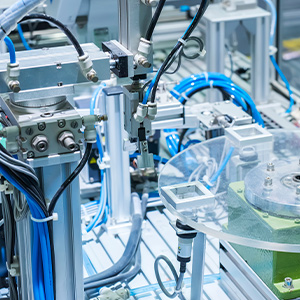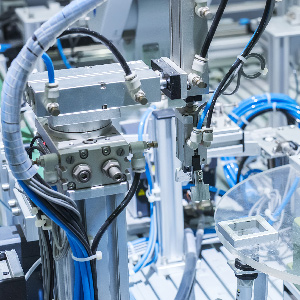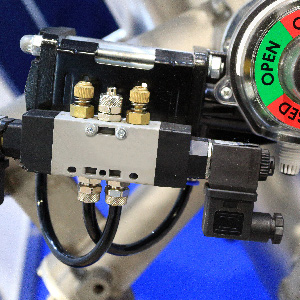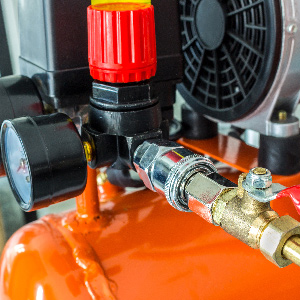Hydraulics Vs Pneumatics
Post By: Ryan King On: 21-04-2020 - Pneumatics
Any type of modern construction or manufacturing application is probably going to incorporate one or all of three different kinds of power: electrical, hydraulic or pneumatic. While some actuators and lifting devices can be purely electrical, using a screw system, it's far more likely that you'll be using some form of fluid power. This means you have a choice between hydraulics and pneumatics.
Pneumatics provides fluid power by means of pressurised air or gases. Hydraulics provides fluid power by means of pressurised liquids, such as oil or water. In choosing one of the two, cost-effectiveness, materials to be moved, availability of resources and space are all factors to be considered. Heavy lifting equipment, for example, takes up a lot of space and requires a great deal more power than the small-scale demands of robotic laboratory or food-processing equipment. Each type of power has its advantages and disadvantages, according to circumstances.
1. Strength
Hydraulics is the best option for strength, because the liquid medium used for its operation has a high mass density and is largely incompressible. This means that hydraulics can develop much higher levels of pressure, and can use that pressure to transmit the power that will drive your application. Industrial applications using hydraulic power may command anything from 1,000-5,000 pounds per square inch (psi) of pressure, while some specialised applications such as mining equipment or heavy lifting cranes can develop 10,000 psi or more.
The fluids used in pneumatics have low mass density and are easily compressible. In some circumstances, gas or air can be compressed up to several hundred psi, but most mechanical applications are based on an operational pressure of only 80-100 psi. This means that pneumatic systems are largely incapable of the much larger force offered by hydraulics, and are unsuited to the moving or lifting of heavy loads. Compressed air is also subject to unexpected pressure drops or fluctuations which can cause operations to become jerky or unstable.
2. Hygiene
Pneumatic systems win out over hydraulics in the field of hygiene, as the only thing that can leak out of your system is air. Within the system itself, the compressed air will be cleaned of oil, water or metal particles, and any other contaminants, by the filtration unit. Pneumatic systems are generally favoured by environmentally-conscious companies or those contemplating greener manufacturing practices.
You'll also be likely to choose pneumatics if you're installing systems in a clean room, a pharmaceutical laboratory, or the food and beverage industry. In these environments there must be absolutely no risk of contamination, so hydraulic systems are generally off-limits as they may be susceptible to leakage.
Whether you choose water or oil in a hydraulic system, either of these may potentially leak out via faulty seals, valves or worn hoses. This will contaminate your clean environment despite any safeguards you may put in place. The presence of liquids may also invite corrosion of the hardware, with a further risk of introducing contaminants. Storage tanks are also required for the fluids, and residues must be disposed of at the end of the operational process.
3. Speed
Speed is one of the pneumatic system's biggest advantages. Compressed air has a high flow rate, which enables the quick release of energy and high-speed motion of moving parts such as actuators. Pneumatic actuators can achieve high cycle speeds and increased duty cycling, which deliver greater productivity. The advantage of rapid cylinder movement is further enhanced by the availability of equipment in very small sizes, ideal for use in applications where miniaturisation is a priority.
Air has a much lower mass density, and can flow much more quickly and easily through pipework. Another advantage of the pneumatic system is that valves and cylinders can quickly alter their state or change direction by dumping their compressed air. This can be voided straight to the atmosphere and requires no further disposal.
Water and hydraulic oil have a much greater resistance than air, with the viscosity of oil making it much slower. Although it will ultimately develop a greater degree of force and maintain constant pressure, it does not have the same rapidity as air movement, and may take longer to get your system running. In the event of a leakage or emergency, hydraulic fluid may not be vented rapidly to the environment, but must be re-routed back to its tank or reservoir.
4. Energy
Comparing hydraulics to pneumatics with regard to energy consumption, there are several factors to consider. Both systems usually require an input of electrical power to drive them, and a pneumatic system needs the continuous running of a compressor to provide the compressed air. The air supply cannot be recycled and requires constant replenishment, so energy consumption in this respect may be high. Any air leakage will also waste energy in the system.
You also have to take into account the fact that pneumatic systems lose energy through heat produced by the compression process – though there are several measures that can be taken to make your system more energy-efficient. Fortunately, air is still free of charge, so there is no need to expend energy in obtaining, replenishing or disposing of waste products.
Hydraulic fluids can use the same oil or water over and over again after the initial start-up. Provided you have a good filtration system and keep it properly maintained, a hydraulic system can be very energy-efficient in the long run. However, electrical power is still generally required to drive the pump, and much of the energy consumed by the pump is wasted. This is because the fluid medium is in constant circulation to maintain system pressure, even though only short periods of actuation may be required to drive the application. The more viscous the fluid medium, the more energy will also be required to move it. However, significant improvements are being achieved, with technological advancements involving different types of pump and the potential of modulating drives.
5. Safety
Considering hydraulics and pneumatics in the industrial environment, pneumatics is undoubtedly the safer option. A leakage of compressed air is not going to cause contamination, since air is not poisonous or corrosive, although other gases used in stand-alone or portable equipment may be hazardous. Compressed air does not generally pose a risk of fire and it won't explode, but the forcible escape of air through mechanical failure may cause physical injury.
Hydraulic fluids, on the other hand, are always at risk of potentially dangerous leaks. Even water can cause damage if it's hot enough to scald. Other fluid media such as oil, ethylene glycol, plasma and fluid synthetics may be corrosive and/or poisonous. The fluid media may be combustible and require extra safety precautions, and used oil or fluids must eventually be drained and safely disposed of. In general, hydraulic systems incorporate fewer mechanical parts, but these may be subject to corrosion and potential component failures.
6. Complexity
Hydraulic systems typically have fewer moving parts and may be easily controlled with push buttons and simple levers. On the other hand, hydraulics rely on complex engineering that requires a system of valves and hoses, as well as a pump powered by an external energy source and a tank for storage of the liquid medium. It is possible to install a centralised power unit in a manufacturing plant in order to control several different hydraulic applications. Newer technology is introducing much better systems of managing speed, pressure and power.
Pneumatic system designs are also typically very simple, and operate at a much lower pressure, so their component parts may be made from cheaper and less complex materials. Since the fluid medium is not corrosive or combustible, precautions do not need to be built in against these safety hazards. Technological advances have increased the variety of uses for pneumatic systems, with miniaturisation and new materials helping to reduce weight as well as bulk.
7. Maintenance
Pneumatic systems are cleaner and easier to maintain than hydraulic ones, since the fluid medium is air. A regular schedule of inspection and preventive maintenance is usually all that's required to keep a pneumatic system running, e.g. checking the seals and making sure there is no leakage of air. The air does need to be cleaned of contaminants, and one of the most important maintenance procedures is the cleaning and regular replacement of the filter-regulator-lubricator unit.
With hydraulic systems, the main issue is corrosion. Unless you’re able to install pipes made of non-corrosive material, such as galvanised steel, regular monitoring will be required to assess how the pipes are being affected by the fluid medium. Water may cause oxidation, and oils or other media may leave deposits that will cause corrosion. Regular checks and replacements will be required for critical components such as seals, hoses and valves.
Context is Everything
The flexibility of air flow, and its precision in use, make pneumatics an obvious choice for such applications as medical tools, dental drills and small-scale robotics. Pneumatics are best employed in specialised environments where hygiene or green practices are paramount, but they are generally impractical for large-scale or heavy lifting duties. Hydraulics are ideal for such high-force applications, and are often found in construction or mining environments. They provide constant torque and force, in spite of any variations in speed, and maintain positional rigidity. At the end of the day, while technological advances continue to improve energy efficiency and performance on both sides, the hydraulic vs. pneumatics question ultimately boils down to context.
Get More From Rowse Straight To Your Inbox




